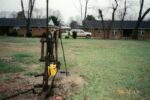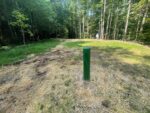- Like
- Digg
- Del
- Tumblr
- VKontakte
- Buffer
- Love This
- Odnoklassniki
- Meneame
- Blogger
- Amazon
- Yahoo Mail
- Gmail
- AOL
- Newsvine
- HackerNews
- Evernote
- MySpace
- Mail.ru
- Viadeo
- Line
- Comments
- Yummly
- SMS
- Viber
- Telegram
- Subscribe
- Skype
- Facebook Messenger
- Kakao
- LiveJournal
- Yammer
- Edgar
- Fintel
- Mix
- Instapaper
- Copy Link
This strategy will probably be used mostly by people who own the surface and the minerals, but whose land is subject to an old (or new) oil and gas lease signed by the current surface owners or their predecessors, and that lease allows the drilling of gas wells on the property. If you own the surface and the minerals and if there are active wells on the property that are holding the lease to the oil and gas, it is probably something you can use.
If you signed a recent lease it may still work, though there may be language in it that specifically allows horizontal wells drilled in bunches, and if so the driller may try to say that negates your right to object to well spacing as a coal owner. We don’t know if the driller’s would be right. So what we are suggesting is worth a try.
This strategy will not work for you if you only own the surface and do not own any of the coal (whether or not you own the gas). If only one coal seem is owned by someone other than you (like the “Pittsburgh”) it will still work for you if you own some other coal seam that meetings the criteria explained below. If you do not own any of the coal, hit the back button and use our other strategies. (Or if you are a friend of the coal owner, maybe they will help you out of the kindness of their heart.) And even if you own the coal, after using this strategy, hit the back button and use the other strategy on that page too.
The Marcellus Shale is a statutory “shallow” formation. (Statutory “shallow” wells can actually be drilled pretty deep into the ground. Remember “non-alcoholic beer”? The statutory distinction has to do with forced pooling and unitization and not the things this strategy is concerned about.) So horizontal Marcellus Shale gas wells are statutory “shallow” wells. (Although the first horizontal well on a pad may first be drilled vertically more than 20 feet into the formation below it (the Onondaga). That would make it s a statutory “deep” well and there are strategies for those you can use, but this is better.)
Generally the West Virginia’s laws do not require statutory “shallow” wells to be spaced any distance apart. (Instead the common law “rule of capture” applies, and drillers have for years crowded multiple wells onto one cheap lease tract to save money while ripping off people investing in the wells, or even drilled wells just on their side of a mineral tract boundary in order to legally steal the gas out from under neighbors.)
There is one exception to the lack of spacing requirements for statutory shallow wells, and that is for statutory shallow gas wells that as they are drilled down through the earth, penetrate down through “workable coal beds”. For safety reasons coal companies cannot mine near gas wells that penetrate through the coal seams. If the gas wells are drilled too close together, they cannot mine the coal in between the wells, or not mine much coal in between the wells. So drilling gas wells close together can sterilize whole blocks of coal. For that reason, the coal companies got laws passed that give them the right to block the drilling of statutory shallow gas wells unless they are to be spaced at least 1500 feet apart!
If you are a surface owner who also owns the coal, then you can use these laws that were intended for coal companies to block gas wells from being drilled unless they are to be spaced at least 1500 feet apart. Since the gas companies want to drill horizontal gas wells in groups from centralized pads, you can block them from using you r land for these monstrous well pads. (Or else you can use this to negotiate a fairer price for the right to use your land. We recommend that you be paid $25,000.00 for each horizontal well that is drilled — after all, each well costs them $3 to $6 Million to drill. Don’t think about what the land is worth to you, think about what it is worth to them to use your land. And make sure they pay you what it is worth to them.)
If you have already received a copy of the driller’s application for a well work permit – ACT QUICKLY.
If you can use this strategy, you will need to file an objection to the drilling permit with the State within only 15 days of the date the “plat” of the oil and gas well was filed with the State by the driller. Usually this plat is filed as part of the driller’s application to drill a gas well. That permit application has to be sent to the owner of the surface where the driller plans to put the well pad or access road. So if you got a copy of the permit application because you are the surface owner, the plat will be included in the packet and you only have 15 days from the date is was filed to get your comments as a surface owner, plus your objections as a coal owner into to the State Office of Oil and Gas of the Department of Environmental Protection. You have to actually get it there, not just get it in the mail.
How do you do get this objection filed?
First, determine if there is a “workable coal seam” under your land. To do that contact the West Virginia Geologic and Economic Survey. This State agency in Morgantown will help citizens like you find out what coal is under them. Or the WVGES has an interactive coal mapping feature on their website you might try to use on your own.
If there is a workable coal seam under your land and you own it, then you can file an objection to putting gas wells closer together than 1500 feet, and the driller is blocked from putting multiple horizontal wells close together on your land! All you have to do is file an objection to the well drilling permit with the West Virginia Department of Environmental Protection, Office of Oil and Gas. The address will be on the well permit application or you can call them or look it up on their home page.
Here is a form to file the objection. (You might want to call the Office of Oil and Gas in Charleston to make sure that this is an up to date form. However, the objection does not have to be in any particular form. You could l just write a letter. BE SURE AND POINT OUT THAT YOU OWN THE COAL and just state that as a coal owner you are objecting to the location of the wells too close together! Do it in writing and send it using a method that gives you a return receipt that it was delivered. You can fax it too, in order to be sure you meet the deadline, but make sure a hard copy is also delivered. Don’t rely on the “mailbox rule”. Get it in the possession of the State within the deadline to be sure you are in time.
(You can also file whatever comments you want to file as a surface owner at the same time. And don’t forget the other strategies we know about. We recommend making the surface owner comments a separate document so the Office of Oil and Gas does not get them confused with your objections as a coal owner.)
At this point, once you have filed your objection, we recommend that you then find a lawyer who knows oil and gas law or even on who concentrates in just coal law. A coal lawyer will know all about these notices and be able to help you too. If the only lawyer you can find does not know about this area of the law, tell the lawyer to contact us and we will guide him or her. This will not take much work from the lawyer we don’t think, so it should not be too expensive.
If you have NOT already received a notice of the driller’s application for a well work permit:
You can just wait until you get the permit application and file the objection then. But we recommend that you do one more thing. The laws say that you can record a “declaration” down at the county courthouse. In that case when the driller goes to file their application for a permit to drill the well, the driller will have to send you a second notice in addition to the notice you get as a surface owner. Not only will you get the surface owner notice, you will get a coal owner notice. Filing the declaration will make sure you get the notice and will help you file your shallow well spacing objection as a coal owner (in addition to your comments as a surface owner) that can be filed for any well. In addition, when they are getting ready to file, if they find your declaration, they might stop right there and move the well pad somewhere else from the git go — or come to talk to you about it then. If they come to you because you are the coal owner, you will have lots of leverage, and they will come to you earlier in their planing process so it will be easier to get them to move the pad.
Here is the form declaration notice you can use to file down at the courthouse.
Below are instructions for filling out the declaration, paragraph by paragraph
Don’t forget the other strategies we know about specifically for horizontal wells grouped on one well site. And don’t forget to file your comments as a surface owner that can be filed for any well.
Declaration Instructions:
Paragraph (1). Find out whether there is a workable coal seam under your land as explained above.
Paragraph (2)(a). Look at the deed to your land. That will usually be the deed by which you came to own the land. If you inherited the land from your parent or grand parent or other relative, find the deed by which they came to own it. (If you do not have a copy, the people at the record room at the courthouse will probably be helpful). Fill in the county where the land is located, and fill in the deed book and page at which the deed was recorded. That is usually stamped or written somewhere on the deed. Again, if you need help, the folks in the record room at the courthouse will usually be helpful in helping you figure out the deed book and page for the deed to your land.
Paragraph (2)(b). Look at your tax bill. Usually your coal and surface will be taxed together. Sometimes they are taxed separately and you will have two tax bills. From the tax bill for the surface get the tax district, map number and parcel number. These tax bills can be confusing and most every county is different, so its hard for us to give you a guide for finding the district, map number and parcel number on the tax bill from your county. If you cannot figure this out, call the county sheriff or assessor (or go down to see them as you file this) and ask them where to look on your ticket, or they may just be able to tell you from looking at their records.
Paragraph (3). It is best if you use an address that is the address for the land itself — if you have a dwelling or other mail box there. That way if you sell it, whoever lives there after you will get the notice. If you can do that, in the “Name” line put “[Your Name] or Current Occupant”. But if you live somewhere else, you can use that address if you would prefer. Or there may be no dwelling or mailbox on the land, or maybe the person that does live there might not be reliable in quickly forwarding mail to you. In that case use a reliable address that is not on the land.
OK you have filled it out. Take it to the record room at the Courthouse and have them notarize your signature and record it. You will get the original back. There will be a small fee.




